- Home
- Peter Matthiessen
The Cloud Forest Page 17
The Cloud Forest Read online
Page 17
April 8. Cuzco.
Here is a rough outline of the journey: from Cuzco we proceed down the Urubamba—it is called the Vilcanota in these upper reaches—to Machu Picchu, and from there to Quillabamba. Beyond Quillabamba there is no scheduled transportation, but apparently there is a road of sorts to a point on the river at its confluence with the Río Yanatili, called El Encuentro. Here the Urubamba becomes navigable, and here we are to be met by César Cruz and three of his men with a small river boat and a canoe. We descend the Urubamba, including a famous rapids called the Pongo de Mainique, and eventually turn off westward up the Río Picha, in search of the ruin. We then return to the Urubamba and descend to the settlement of Atalaya. There we pick up Vargaray and head eastward again into the Inuya and the Mapuya, where we hope to locate and retrieve the famed mandíbula. We then return to the Urubamba and to Atalaya, from where we descend the Ucayali to Pucallpa. Whether or not we locate bone or ruin, we will have traveled close to a thousand miles on the jungle rivers.
This, as I have said, is the rude itinerary; we can’t know more about it until we have spoken with Cruz himself. The last word from him was a cable from Atalaya to Lima which required four days to arrive (in the United States a cable is sent or it is not, but this system would offend every custom in South America, where inefficiency is an art nothing less than awe-inspiring) and signally failed to take into account a cable of questions and instructions sent off by Andrés a week before. This indicates that he failed to receive Andrés’s cable—or rather, one hopes that this is what it indicates, the alternative being damaging to one’s faith in the trusty Cruz. César’s cable stated that he would meet us at El Encuentro on April 10, which would leave him so little time for the journey up the Urubamba that I wondered if he did not mean the encuentro, or confluence, of the Tambo-Urubamba, near Atalaya. But Andrés had been in Pucallpa two weeks before and had carefully established with Cruz’s wife—Cruz himself was absent—that the encuentro in question was the one near Quillabamba. He did not feel there could be any honest confusion on the point.
In any case, Andrés and I will be at El Encuentro the day after tomorrow. As for Cruz, only time will tell.
Because we have no idea, owing to communications failures, of the completeness of Cruz’s preparations, our three days in Cuzco have been largely devoted to minor outfitting—curarina, or snake medicine, malaria pills, meat sauce (for monkeys and other doubtful provender), machetes, and so forth. Fortunately Andrés was already well equipped with more basic material, including a pup tent, hunting knives, waterproof river sacks for our gear, a .44 Winchester carbine, and a portable radio. In addition, he has lent me a .38 revolver, as one is never certain what manner of unfriendly beast one may encounter in the selva.
While in Cuzco I had a look at several books of Peruvian exploration, through the kindness of Señor Benjamino de la Torre, and one of these, the South American Adventures of an Englishman, Mr. Stratford Jolly, directly concerned the Urubamba region. Mr. Jolly, in 1929, descended the Urubamba, though he was not the first Briton to do so: the previous year Mrs. Bertha Cox, an evangelist of sixty-five and “a courageous and very obstinate old lady,” had made her way down the valley with an immense amount of luggage, after suffering incredible maltreatment at the hands of the settlers near the headwaters. Turning the other cheek, Mrs. Cox “gave the people who had treated her so abominably most of her chickens, in return for which they stole her dog, and followed the party for some hours down through the forests along the river-bank, in the hope that the canoe would upset and that they would be able to salve and steal the cargo.” She survived her journey only through the assistance of “the rubber trader Peyrera, who was absolute king of the river below.” Among the river people, this man had a very evil reputation—he was, among other things, a murderer—and Jolly himself was apprehensive. But he then received a message from the trader, who hoped to prove that “there were still decent people to be found, even in the inaccessible mountains of Peru.” And in fact Jolly and his party were treated with utmost courtesy. With the help of Machiguenga Indians attached to Peyrera, both Mrs. Cox and Mr. Jolly were portaged past the Pongo de Mainique—an awesome place, to judge from his account—and arrived eventually at the settlements on the Ucayali.
The one other reference to this region I have come upon to date occurs in a work called The Rivers Ran East by an American, Leonard Clark: I came across this volume in La Paz. Mr. Clark, with a single Peruvian companion, descended the Andean rivers—the Perene and the Tambo, farther east—to Atalaya and Pucallpa, and his adventure, therefore, might be said to parallel closely the one which lies before us. (I hope, I must own, that all parallels have already been stated. In his very first hours in the wilds Clark is threatened by a huge rattlesnake, by a jaguar which approaches to a point fifty feet away, and by his own companion, who threatens to blow Clark’s head off. From this point forward he is exposed almost constantly to assault by Indians, piranhas, crocodiles, vampire bats, and poisonous reptiles of “intense cunning,” an “immense” specimen of which, in the climactic chapters, succeeds at last in burying its fangs in the author’s throat. Since the wound adjoins the jugular, Mr. Clark is unable to bleed it, an irony which causes him to laugh; in a calm voice he informs his companion that he has four or five minutes to live, and it looks very much as if the constant prophecies of his certain doom are about to be borne out. But an Indian leaps into the jungle and gathers, prepares, and administers a potion unknown to science in the allotted time, thus sparing the author and his exciting story for the publishing firm of Funk & Wagnalls.) Despite the successful passage of Mrs. Cox and others two decades before the period of which he writes, Clark speaks of “the forbidden Urubamba” and the terrible savages who control it. Here, as elsewhere, he appears to have been the victim of considerable misinformation, a minor example of which is a report that in recent years a trader named Pereira was killed by Machiguenga slaves while attempting to establish a holding above the Pongo. The holding, of course, was established before 1920, and Pereira is still very much alive. He is said to be a most interesting man, and both Andrés and myself now hope to meet him.
Andrés once lived in Cuzco, and I have been here previously, which accounts for our failure to take advantage of its Inca splendors or the more vulgar monuments of the colonial Church. Also, Andrés has many relatives here, and these kind people, and especially his sister-in-law, Gloria Estelle Ladrón de Guevara León de Peralta, have seen to it that our every free moment was assigned to food and drink. Nevertheless, we took time to revisit the Inca fortress of Sacsahuaman above the city, and let the bare sun and distances of the sierra seep into our souls. Andrés, however, is bothered by the altitude, and the mountains themselves oppress him; he is anxious to get down into the jungle. I agree and am, in fact, nearly beside myself with anticipation.
April 9. Quillabamba.
Our last evening in Cuzco, with Estelle de León de Peralta and a friend from Lima, Celeste Allen, we celebrated something or other until very late, and as we had to rise at 5:30 a.m. to catch the ferrocarril to Machu Picchu, the expedition got off to a fairly painful start. But the mountain day was so clean and clear as to shock us back into awareness, and as the valleys of the Urubamba region are the loveliest I have ever seen, the journey was the greatest pleasure.
The ruins at Machu Picchu have been described in detail, ineffectually, by any number of writers, including myself (in Chapter III); one must see the place to comprehend it, and that is that. Like all the rest, I find it a formidable spectacle, unforgettable; in conjunction with Cuzco and its environs, with Ollantaitambo and the other mountain ruins, with the stark Puno and the clear, flowered valleys, it is the principal sight of South America and sufficient justification in itself for a visit to that continent.
This area of the Inca world, from Machu Picchu southeastward to Lake Titicaca, Tiahuanaco, and La Paz, is serviced with efficiency and, more remarkable still, a concept of hygiene bordering on outrigh
t cleanliness. The rare wayfarer who leaves Machu Picchu in the wrong direction—northward, that is, toward Quillabamba, rather than back to Cuzco—will notice a marked change in service the moment he sets foot on the crowded ferrocarril which proceeds down the valley. Andrés and I clambered aboard in the late afternoon, waving good-by to Celeste Allen and another excellent American named Colonel Tooey, who had accompanied us as far as Machu Picchu. Celeste, a very attractive woman, is a veteran of the jungle, and on the strength of some farewell pisco sours we were almost able to persuade her to accompany us; as it was, she located a bottle of Scotch somewhere in Machu Picchu, and we now carry it with us, to be drunk in her honor at the Río Picha if we find the ruin, at the Mapuya if we find the bone; failing both, it can always be smashed over the head of César Cruz. The car was scarcely out of sight around the bend when the track petered out entirely at a large hacienda of the montaña, or “high jungle,” called Huadquina. Here we changed to a dirt road and the inevitable góndola, or miniature bus, with its protruding limbs, packages of food, and redolent good cheer, and journeyed on in the soft twilight toward Quillabamba.
Some parakeets seen above Machu Picchu were the first signs of the montaña, but other signs now began to appear. These were the red-flowered air plant bromelia, and the strange hanging nests of the black and yellow river oriole. The river itself remained turbulent and unnavigable, its brown color in vivid contrast to the white mountain torrents which dove into it at the mouth of each ravine. When the sun went down, the clouds of mist still drifted in the valley like dirigibles; the valley itself had gradually grown wider. By the time the góndola reached Quillabamba, night had come.
April 10. El Encuentro.
Quillabamba is the capital of the province of Concepción, but its streets are of mud for all of that, and its best hotel and restaurant undistinguished to the point of simple filth; the hotel’s communal toilet had a roof, however, and the restaurant personnel, though barefoot, sadly soiled, and otherwise informal in their appearance, were friendly and fleet of foot. After supper, attempting to locate a ride to El Encuentro, we walked a considerable distance around the town, which is perhaps not at its best beneath weak street lights.
Unhappily, we were to see it no other way, for long before dawn we were off in a market truck through the montaña valleys (though the mountains still tower around us, the altitude of the valley floor is now less than four thousand feet). The dirt road, often no more than a ledge, skirted the steep banks of the river below; the torrent could not be seen, but it roared from directly beneath us in a way which was very disconcerting.
The jaguar and the Andean bear, the driver told us, were common creatures of this region; a glimpse of either would have started the journey auspiciously, and I kept a sharp lookout ahead, in the yellow headlights. But we met instead with a strong smell of skunk, and an animal of this family, a mustelid called the raposo, sidled furtively, with neither grace nor speed, into some roadside weeds. This creature, rather than the jaguar or bear, was the first animal recorded by the expedition. There then charged across the road, missing first place by a matter of seconds, a diminutive mouse or shrew.
Like many places featured on jungle maps, El Encuentro marks only a geographical location and has no settlement of any kind. The road, in fact, comes to an end a few miles short of it, at the hacienda known as Qquellouno (a Quechua word for “yellow water”; there is a small stream of this color flowing through the hacienda, down into the Yanatili, which forms the encuentro with the Urubamba). Yanatili is also a Quechua word, slightly corrupted; roughly, the name means Black Drunken River. Though the torrent is dark gray, the name is otherwise a good one, for the river comes sprawling down out of the mountains in rolling curves, pitching beneath the foot-bridge by the hacienda at an awesome rate before losing itself in the brown Urubamba.
We arrived at Qquellouno just after light and a little later walked to the encuentro. The path rises steeply through a grove of cacao trees: the hacienda concentrates on coffee and cacao, though it also grows choclo (maize), yuca (manioc, or cassava), tea, and coca, the Quechua narcotic and source of cocaine. It enters the forest, then descends abruptly to the river once again. A blue morpho butterfly accompanied us part of the way, bouncing along just ahead of the Quechua boy who guided us; butterflies of numerous species, some a lovely fire color, were sunning their wings everywhere. There were also the inevitable files of marching ants—and I did not have to be told to run through them quickly, having learned this elementary jungle lesson in Mato Grosso. (One also learns quickly not to lay one’s hand or lean casually on tree limbs, which are often spined and sometimes ant-ridden, or worse.)
The encuentro itself was lovely, reminiscent of a Montana mountain river, gravelly and swift, with a morning breeze and a wet sparkle in the leaves. But there were also incongruous cloud islands against the dark, thick mountainsides, providing that air of mystery and vague threat so common to landscapes in South America.
Cruz was not at the encuentro, and a Quechua who worked a chacra there said there had been no sign of him.
The path back up onto the ridge was slippery and steep, and the day, though still early—it was only nine—was fiercely hot. Our guide bounded ahead, and Andrés and I pursued him. Though in pain, we did not stop to rest, and I gradually became aware that we were indulging in some sort of competition, trying each other out, so to speak, though I don’t believe that Andrés was aware of this. The competition was foolish; Andrés is nearly twice my age, and a man in his early sixties has no business hurrying on such a slope, despite the fact that his physical condition is far superior to my own. Andrés is an athlete and rightly proud of his condition: he does not smoke, drinks very little, and continues to surfboard, Hawaiian-style, in the long waves of the Pacific. A man’s heart does not always pay attention to good intentions, however, and his very doggedness worried me a little. I remained ahead of him and, by feigning near-mortal fatigue, managed to slow him down. Not that fatigue was difficult to feign, for I was soon exhausted. When in good shape, I perspire very little, but now I was exuding a mixture of pisco and general effluvia which kept even the sweat bees at a respectful distance, and was in addition gasping like a sungaro, as the giant catfish of Amazonas are known. But to return to the competition: Andrés is a jungle veteran, hard as nails and anxious to instruct a greenhorn, while I am neither jungle veteran nor hard as nails, but stubborn. So I suppose, until we are broken in, we shall have to sniff each other out a bit, like dogs.
Actually, after five days together, we get on very well. This is a credit to Andrés rather than to myself, for I am somewhat unpredictable, given to long fits of speech and jollity when pleased but otherwise rather moody, while Andrés is cheerful by nature, I think, and, though talkative, very gentle and soft-spoken. The gentle quality of his voice, in fact, is one of the first things one notices about him. He is a very sympathetic man, in the Spanish sense of muy simpático.
Andrés’s grandfather was a national hero of the Chilean War, from 1879 to 1883, and a former President of Peru; his cousin, Raoul Porras, is now Foreign Minister. Both Andrés and his wife are descended from Spanish and Inca nobility, and he is intensely proud of this; though he gets on well with everyone and prefers humble people to his own sort as a matter of taste, he is very conscious of his background and quickly establishes his identity with anyone who might not recognize who he is. If he is gentle, he is also quick-tempered; in Cuzco the other evening, jostled by a man in the hotel, he climaxed an exchange of views by announcing his identity. The other man, who clearly felt that he himself was the victim of the jostling, expressed indifference, at which point Andrés jostled him smartly once again. I was forced to seize my companion from behind and turn him away, in order to prevent bloodshed. Andrés is small but thick and powerful, an ex-boxer who once defeated a Peruvian champion, an ex-governor of the wild jungle state of Madre de Dios who was fond of emphasizing his points by discharging his revolver—the revolver I carry with me—
within the confines of his office.
Cruz did not appear during the day, nor is there much hope that he will come tomorrow. Every man on the hacienda has a different concept of the country and its distances—not one has ventured even as far as the Pongo de Mainique—but all agree that Cruz has not allowed himself sufficient time to navigate the river, much less the Pongo, at this time of year.
We are occupying an open shed lent to us through the courtesy of the patrón, Señor Abraham Marquez; the room faces out on stone terraces used for drying coffee beans. Beyond, among the huts of the Quechua laborers, wander cattle, pigs, chickens, dogs, and ducks. There are also peacocks, and two of these birds are perched on the arm of a huge wooden cross which stands at the corner of the terracing.
In the afternoon the tropic rains came crashing, and the Indians scuttled to gather in the drying beans. Afterward the place stewed in the sweet odor of pig and chicken dung, and of the surrounding selva cerca, or near-jungle. Andrés is still optimistic that César will appear this evening, while I am already regarding covetously the heaps of coffee beans in the adjoining shed: these would make an excellent place to lay our bed rolls. But Gregorio, Marquez’s suave administrador, has conjured up two slat beds and two mattresses, and we are to sleep in comparative style. At six it is already dark, and as these river haciendas—even a very stylish one like this—have none of the ordinary comforts like electricity, there is little to do by eight o’clock but go to bed. Outside, a rooster crows half-heartedly, and the air is filled with the ominous rush of the Black Drunken River.

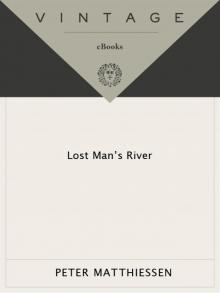 Lost Man's River: Shadow Country Trilogy
Lost Man's River: Shadow Country Trilogy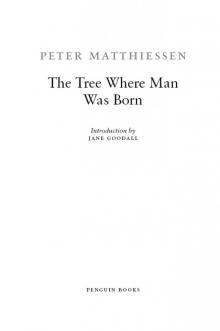 The Tree Where Man Was Born
The Tree Where Man Was Born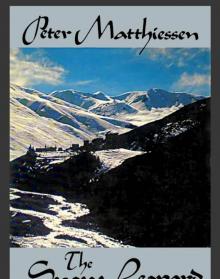 The Snow leopard
The Snow leopard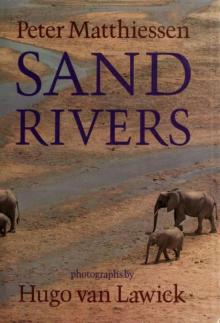 Sand Rivers
Sand Rivers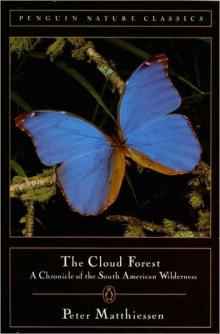 The Cloud Forest
The Cloud Forest Sal Si Puedes (Escape if You Can)
Sal Si Puedes (Escape if You Can) Far Tortuga
Far Tortuga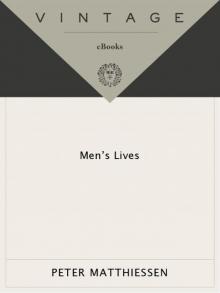 Men's Lives
Men's Lives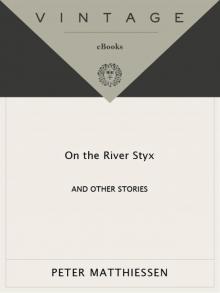 On the River Styx: And Other Stories
On the River Styx: And Other Stories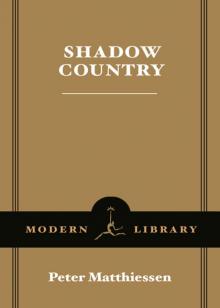 Shadow Country
Shadow Country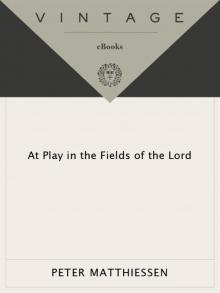 At Play in the Fields of the Lord
At Play in the Fields of the Lord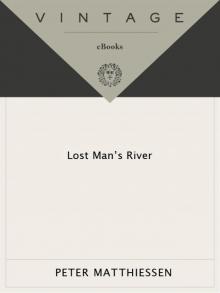 Lost Man's River
Lost Man's River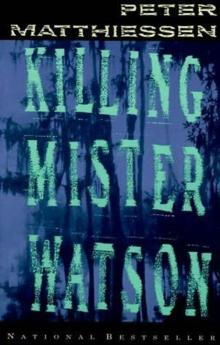 Killing Mister Watson
Killing Mister Watson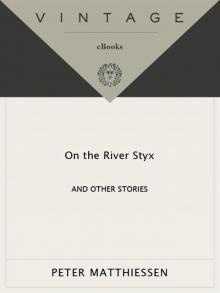 On the River Styx
On the River Styx